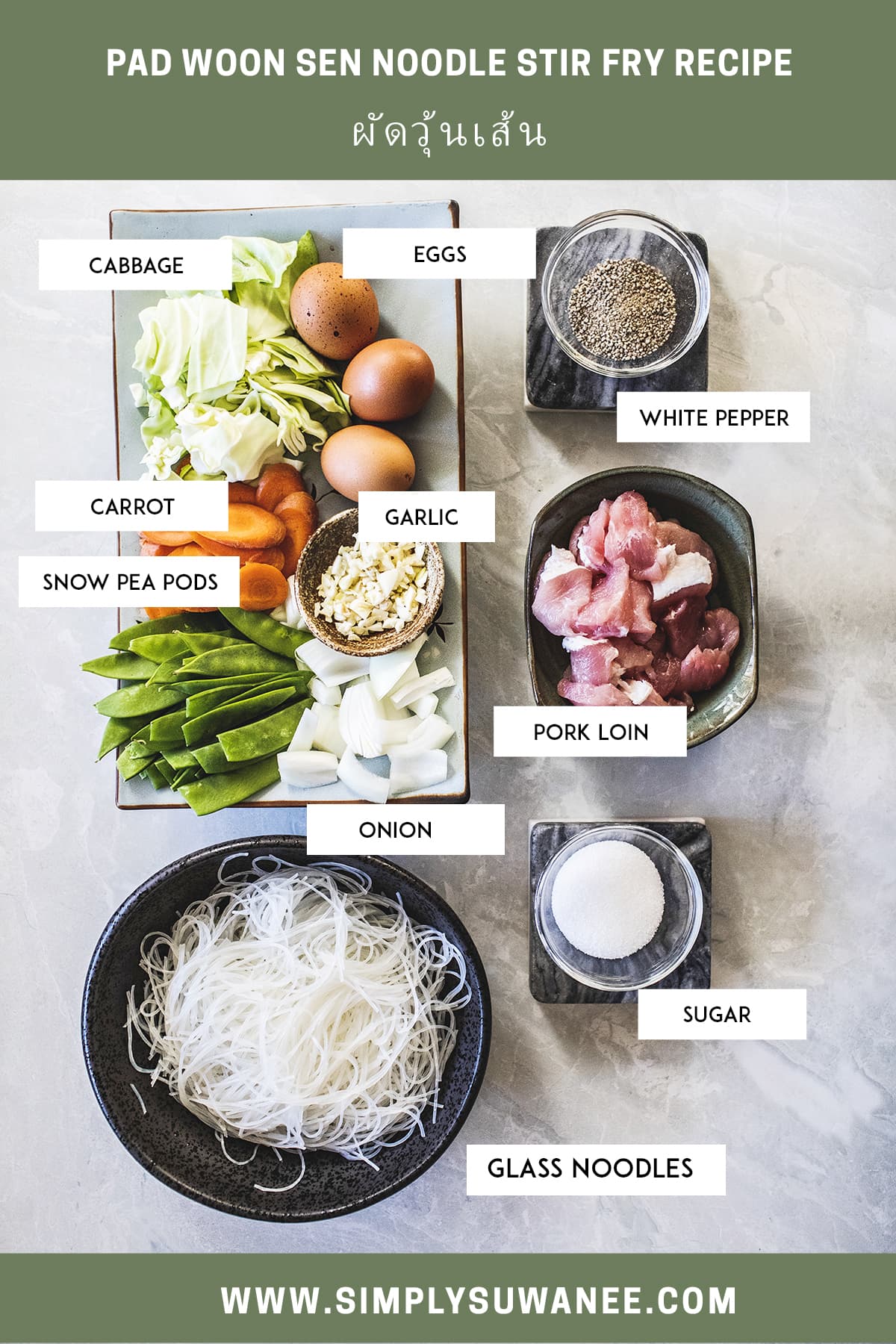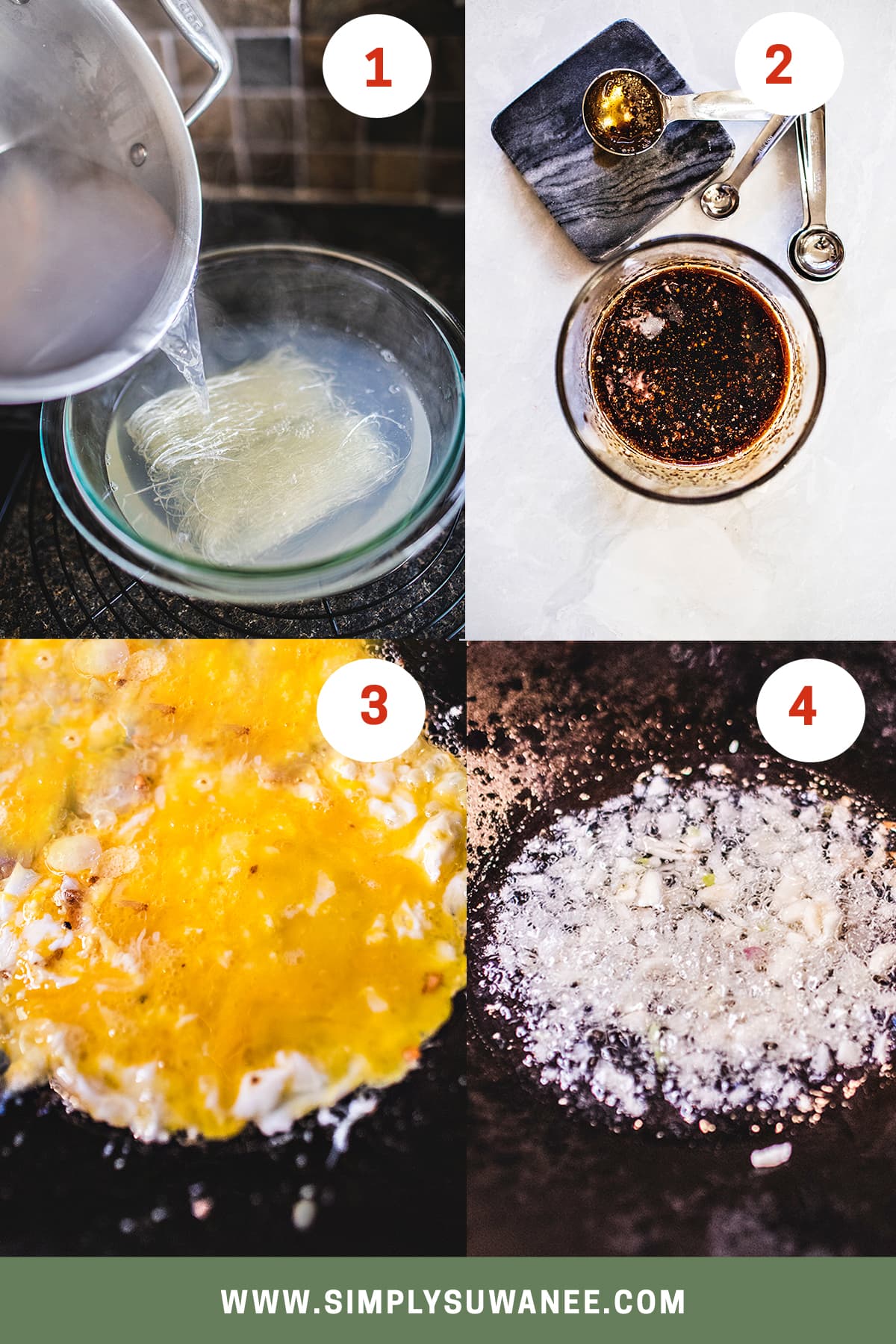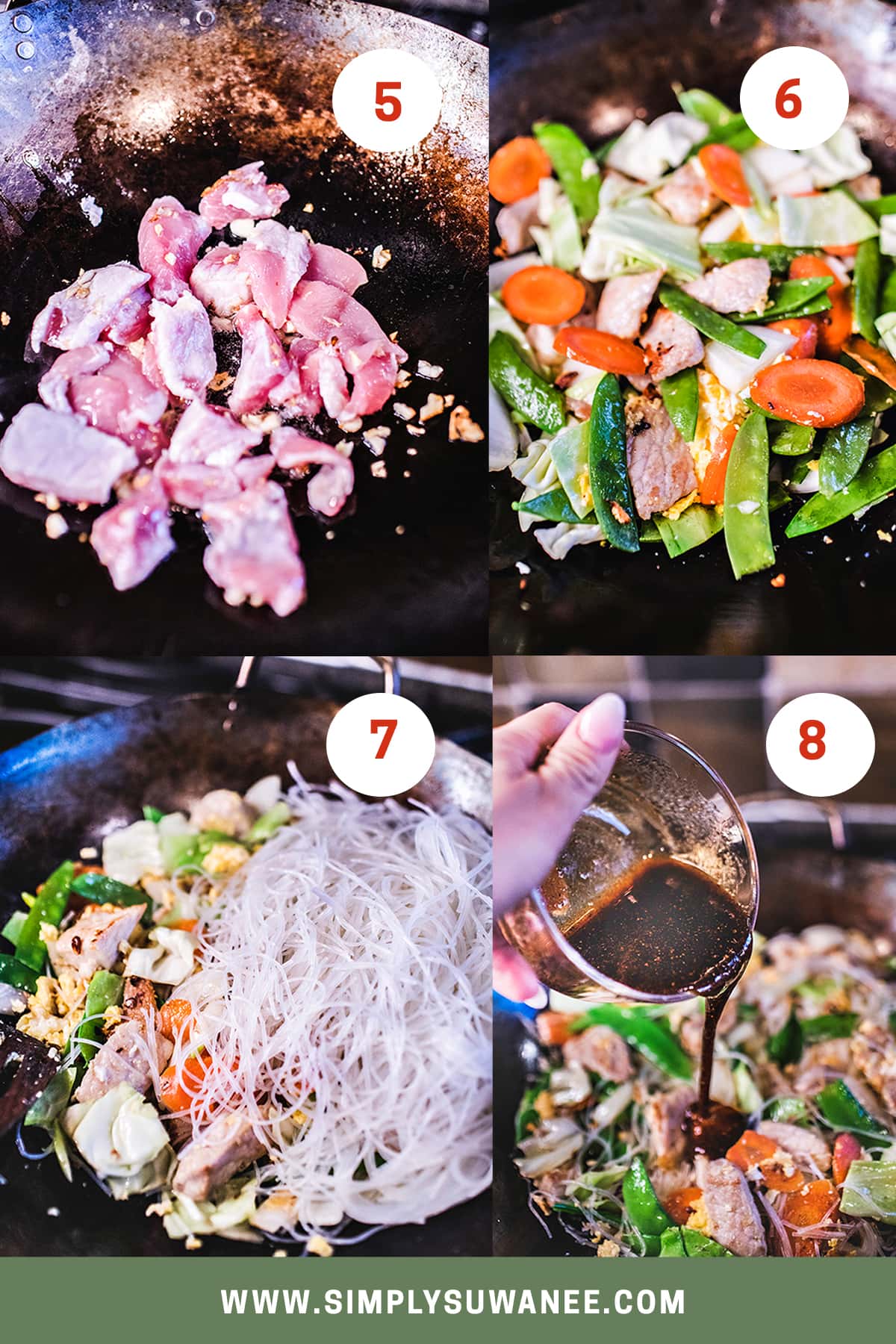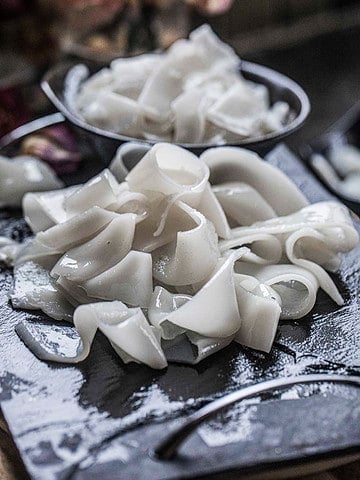Pad Woon Sen Thai glass noodle stir-fry recipe is a classic Thai noodle dish with savory, umami stir-fry sauce made with soy sauce and then stir-fried with silky smooth glass noodles, protein, and healthy vegetables. It is an easy recipe with delightful flavors and a quick meal for lunch or dinner!

Growing up in a small Thai village, I learned the art of cooking from generations of home cooks, and I've put that experience into perfecting this Pad Woon Sen recipe. This comforting glass noodle stir-fry combines a rich, savory sauce, fresh veggies, and silky noodles—simple ingredients that pack in the vibrant flavors of Thai tradition. With just a few easy-to-find ingredients, you can whip up this authentic dish and bring a taste of Thailand right into your kitchen.
Check out these easy Thai recipes using glass noodles. Thai glass noodles soup-Gaeng Jeud, Gai Yum Woonsen, Glass noodles salad with turkey meat.
Learn more about the different rice noodles used in Thai cooking here.
Jump to:
What is Pad Woon Sen?
Pad woon sen (ผัดวุ้นเส้น) is a Thai glass noodle stir fry dish using a type of noodle that is known as glass noodles. The thin noodles are made from mung bean starch, giving them a glossy, clear look.
These noodles are called Woon Sen in Thai and are used in stir-fries, soups, and salads. Pad means stir fry in Thai, so Pad Woon Sen is a Thai clear glass noodle stir fry dish popular worldwide.
Learn more about the different kinds of Thai noodles used in Thai cooking here. Also, this useful blog post talks about the 13 essential sauces used in Thai cooking.
The many names of glass noodles
Since this is the main ingredient for this recipe, I thought it's worth mentioning all the different names this noodle is called. Find These noodles at any of your local Asian grocery stores. Are you ready? (;
- Cellophane noodles
- Bean thread noodles
- Mung bean noodles
- Silky glass noodles
- Mung bean threads
- Rice vermicelli clear noodles
- Woon Sen
Why You'll Love Pad Woon Sen Noodles
- It's easily adaptable with what types of protein to use. Pork, beef, chicken, shrimp, tofu, or tempeh are all great choices.
- Pick any of your crunchy vegetables to use for the stir fry. Green beans, asparagus, broccoli, carrots, and peppers are great cooking options.
- Pad Woon Sen sauce can be made ahead of time! You can make the sauce a few hours ahead to help speed up the stir-frying!
- Pad Woon Sen is not a spicy dish! But you can easily change that if you are a spicy food lover. Add white pepper, Thai chili flakes, or chopped fresh Thai chilis with fish sauce.
- This recipe is a quick recipe to put together. It’s even faster than tofu or shrimp because they don’t take long to cook.
- It is a filling yet still light dish. Pad Woon Sen has a ton of added vegetables, making this recipe a healthy dish.
- It's a crowd-pleaser! This recipe is one of my favorite Thai dishes for a large crowd. Easy, fast, and always delicious.

Pad Woon Sen Ingredients
Below are the ingredients you'll need to make this authentic Pad Woon Sen glass noodles recipe. Feel free to screenshot these photos for items and specific brands you need to get the exact flavors.
Many of these items can be found at most local grocery stores, whereas the sauces can be found at Asian markets.
The stir-fry ingredients

- Glass noodles. Soak in hot water until soft. You can use boiling water, too, but no more than 5 minutes of soaking. Glass noodles are sturdy and can handle hot water just fine. I microwaved the noodles in a water bowl for 3-5 minutes, which was fine.
- Protein. You can use any of your favorite proteins like pork, chicken breast, chicken thighs beef, shrimp, and tofu for the Pad Woon Sen recipe. I used thinly sliced pork loin.
- Eggs. Eggs give this recipe extra protein and umami flavors.
- Cabbage. Chopped 1.5 inches wide
- Onion. Use purple, white, or sweet onion.
- Carrots. Carrot chips are perfect for this recipe.
- Snow pea pods. Almost a requirement, in my opinion. (:
- Ground white pepper. Feel free to add more or less as preferred for taste buds. Use black pepper for a less spicy flavor. Read more about Thai spices here.
- Sugar. Use white, palm, or brown sugar.
- Oil. Use canola, coconut, or vegetable oil. No olive oil for this Thai recipe, please.
- Garlic. Garlic makes everything tastier! Read more about Thai herbs here.
The sauce ingredients
These sauces are needed to make a savory sauce for these stir-fried Thai glass noodles. Learn more about the different types of sauces used in Thai cooking here.

- Oyster sauce. The go-to ingredient for stir-fry sauce
- Fish sauce. Adds a nice touch of salty and umami flavor to Pad Woon Sen.
- Thin soy sauce. Also called light soy sauce. Use any regular soy sauce as a substitute.
- Dark soy sauce. It adds a deep dark golden color to the clear noodles. Find these at your local Asian market. Molasses is a great substitute.
- Rice wine vinegar. Rice vinegar is used to help add balance to the sweet sauce. You can use apple cider vinegar or lime juice.
- White pepper. White pepper is a must for this pork Pad Woonsen recipe. It’s an ingredient that sets the recipe apart by giving it a very distinctive flavor.
The Golden Mountain sauce is often used in many stir-fry dishes in Thailand. If you can find some, add about 1 teaspoon to your stir fry for an added flavor enhancer.
Vegetable Suggestions
- Vegetables. The Pad Woonsen stir-fry recipe is very adaptable regarding what vegetables to use. Snow pea pods are a must for this recipe! I highly recommend using them in this recipe.
- Other great options are Broccoli, broccolini, shitake, portabella, wood ear mushrooms, bell peppers, Chinese broccoli, stems, shallots, and green/ spring onions.
Helpful kitchen tools for this recipe
How to Make Pad Woon Sen
Step 1. Soak the noodles in hot water in a large bowl for 5 minutes. Once the noodles are soft, drain and set aside until ready to cook.
Step 2. Make the stir-fry sauce by mixing the sauces, sugar, and white peppers in a small bowl. Set aside.
Step 3. Heat a wok, a large skillet, or a large saute pan over medium-high heat. Add the oil, but save 1 tablespoon for later. Add the eggs and scramble.
Leave the eggs in large pieces if possible. Remove from the wok and set aside on a plate for later.
Step 4. Add the rest of the oil to the wok, add the garlic, and cook until light golden brown. It takes about 15-30 seconds.

Step 5. Add the pork, and cook for 3-4 minutes or until the meat is light golden brown. Turn the stove to medium heat if your meat is getting too dry.
Step 6. Add the vegetables, stir everything together, and cook until the vegetables are slightly tender, for around 3-4 minutes.
Step 7. Add the glass noodles and scrambled eggs and stir well.
Step 8. Pour in the sauce, stir well, and cook for 2 more minutes. Turn the heat off and serve!

Garnishing options
- Garnish your finished Pad Woon Sen with red pepper flakes, ground white pepper, lime wedges, fresh cilantro, or thin green onions.
- In Thailand, restaurants, stalls, and shops typically have a set of condiments to add as extra flavoring to the food you're ordering.
- One of my favorite condiments, a flavorful sauce called Prik Nam Pla, is a chili sauce made with fish sauce, minced garlic, and vinegar.
- If you feel up for it, try it; it can be used for many recipes. Add these 3 simple ingredients together until you love the flavor.
- Sprinkle a few dashes on your Pad Woon Sen, and ENJOY!

Pad Woon Sen Recipe Tips
- The soaked glass noodles should be soft enough for the strains to wrap around your fingers. El dente noodles are not recommended for this Thai noodle stir fry.
- Room temperature or cool water works fine, too, for soaking the glass vermicelli noodles. It will take longer than warm or hot water, up to 25-30 minutes longer.
- Don’t skip the white pepper in this recipe. To me, this is the ingredient that sets this recipe apart from the other stir-fry dishes. It has a distinctive strong, peppery, and earthy taste that is hard to find substitutes for.
- Use whole peppers and grind them to powder for even fresher peppers.
- White pepper is spicier than black pepper. Use a little bit at first and add more to the dish after if needing more heat.
- Rice wine vinegar. This Thai pad woon sen recipe also has that little extra flavor. It helps offset the salt and sweetness from the sauces. It will add just a nice touch of tang but will not take away from the integrity of the traditional Wad Woonsen dish.
- The scrambled eggs. You can cook it separately, set it on a plate until ready to mix in later, or cook it next to the pork (or other protein) right before the meat is almost done.
Pad Thai Woon Sen Variations
- Make your pad Woonsen vegetarian by adding firm fried tofu instead of the meat.
- Use vegetarian oyster sauce for a vegetarian version.
- Great vegetables to add to the Thai stir-fried noodle dish. Snow peas, baby corn, shiitake mushrooms, napa cabbage, bean sprouts, mung beans, and green onions.
How to Store Pad Woon Sen
Leftover Pad Woon Sen stays in the refrigerator for 2-3 days. Keep any leftovers in an airtight container and heat them in the microwave or on a small skillet until lightly warm.
FAQs
The main difference between Pad Thai and Pad Woon Sen is the type of noodles and sauces used for each.
Pad Woonsen uses clear glass noodles, while Pad Thai uses flat rice noodles.
Pad Thai sauce has tamarind juice, sugar, and fish sauce, while Pad Woon Sen sauce has different soy, fish, and sugar combinations.
They are. They have fewer carbs because of the lighter ingredients used to make glass noodles. The glass noodles are made from vegetable starches like mung bean, potato, and pea flowers, making the noodles light and low in calories.
In Thai, Pad means “stir-fry,” and Woon Sen means clear noodles, referring to the type of noodles commonly used in Thai food.
When softened and cooked, the noodles are made from mung bean, pea, or potato flour and have a chewy, fun texture.
They are usually packaged as dried noodles wrapped into small bunches in a plastic bag and then covered in a pink or blue net. These glass noodles are found in most Asian markets and at your local grocery store.
More Thai recipes you'll love
- Thai Glass Noodles Salad with Shrimp
- Chicken Yum Woon Sen, Thai glass noodle salad
- Thai Rice Noodles
- Easy Pad Thai noodles with beef
- Pad See Ew
- Pad Kee Mao, Drunken noodles
- What is palm sugar
**Love a recipe you've tried? Please leave a 5-star rating in the recipe card below and a review in the comments section further down the page. Or follow me on Facebook, Pinterest, or Instagram!**
Print
Pad Woon Sen Noodles Recipe (Thai Glass Noodles)
- Total Time: 25 minutes
- Yield: 6
- Diet: Low Lactose
Description
Pad Woon Sen Thai glass noodle stir-fry recipe is a classic Thai noodle dish with savory, umami stir-fry sauce made with soy sauce and then stir fry with silky smooth glass noodles, protein, and healthy vegetables. It is an easy recipe with delightful flavors and a quick meal for lunch or dinner!
Ingredients
- 5-6 ounces dried glass noodles, soaked in warm water before cooking
- ¼ cup oil, vegetable, canola, coconut, or sunflower oil
- 5 cloves of garlic, minced
- 8 ounces pork loin, thinly sliced
- 1 cup cabbage, chopped 1.5 inches wide
- ½ cup onion, chopped into 1.5 inches wide
- ½ cup carrots, chopped into 1.5 inches wide
- ½ cup whole snow pea pods, trimmed on both ends
- ½ teaspoon - 2 teaspoon ground white pepper. Feel free to add more or less as preferred. * Check kitchen notes below.
- 1 tablespoon sugar, white
- 3 tablespoons oyster sauce
- 1 ½ tablespoon thin soy sauce
- 1 tablespoon dark soy sauce. See note for substitute
- 2 teaspoons fish sauce
- 2 teaspoons rice wine vinegar
Instructions
- Soak the noodles in hot water in a large bowl for 5 minutes. Once the noodles are soft, drain and set aside until ready to cook.
- Make the stir-fry sauce by mixing the sauces, sugar, and white peppers in a small bowl. Set aside.
- Heat a wok, a large skillet, or a large saute pan over medium-high heat. Add the oil but save 1 tablespoon for later. Add the eggs and scramble. Leave the eggs in large pieces if possible. Remove from the wok and set aside on a plate for later.
- Add the rest of the oil to the wok, add the garlic, and cook until light golden brown. It takes about 15-30 seconds.
- Add the pork, and cook for 3-4 minutes or until the meat is light golden brown. Turn the stove to medium heat if your meat is getting too dry.
- Add the vegetables, stir everything together, and cook until the vegetables are slightly tender, for around 3-4 minutes.
- Add the glass noodles and scrambled eggs and stir well.
- Pour in the sauce, stir well, and cook for 2 more minutes. Turn the heat off and serve!
Notes
- Don’t skip the white pepper on this recipe. To me, this is the ingredient that sets this recipe apart from the other stir-fry dishes. It has a very distinctive strong peppery and earthy taste that is hard to find substitutes for. Use whole peppers and grind to powder if the options permit. White peppers tend to be spicier than black peppers, use it sparingly, you can always add more at the end too if you need more heat.
- Rice wine vinegar. This is also that little extra something in my recipe that will help offset the salty and sweetness from the sauces. It will add just a nice touch of tang but will not take away from the integrity of the traditional Wad Woonsen dish.
- The scrambled eggs. You can cook it either separately, set on a plate until ready to mix in later or you can cook it next to the pork (or other protein) right before the meat is almost done. Then you add the vegetables, noodles, and sauces.
- Prep Time: 15
- Cook Time: 10
- Category: Noodles
- Method: Stir Fry
- Cuisine: Thai









Lydia says
Incredible recipe! Thank you so much for sharing. We made it twice in 3 days it was good! ❤️
Suwanee says
That's so great, I love it that you enjoy it so much and are so great at adapting to your heat level! Thank you, Julie!
Julie says
I did make it again already because we loved it so much [even the very spicy first version] and it is heaven! Thank you for this recipe!
Suwanee says
Oh, I'm sorry to hear that it was so spicy, Julie. Thank you for the helpful feedback! I changed the ratio now to be less with the option to add more. (:
I do realize more and more that my taste bud is quite spicy and have to be mindful of others who aren't as tolerant of heat in Thai food. This comes from my background of growing up eating food from the Issan region where food is quite fiery in flavors. I hope the adjustment is helpful to you and you'll give it a try again. (;
-Suwanee
Julie says
Hi! This recipe is DELICIOUS - love the sauce - but I think the measurement of white pepper isn't quite right...since pad woo sen isn't supposed to spicy, 1-2 TBSP is quite a LOT of white pepper. I used less than 1 TBSP (I didn't want to veer off too far from the original recipe, because, who knows, what if I was wrong?) but the dish is so spicy. Very, very, very spicy. The sauce is so good without it- I would add a dash of white pepper at most. 1 TBSP of white pepper made the dish so overpoweringly hot that we could hardly even taste the other elements to it. This could also be a difference of preference- but it is very, very hot. I'm not sure an American looking for a not-so-spicy Thai noodle dish would go for it with this amount of pepper LOL. I just thought you ought to know- it could also have been a typo!